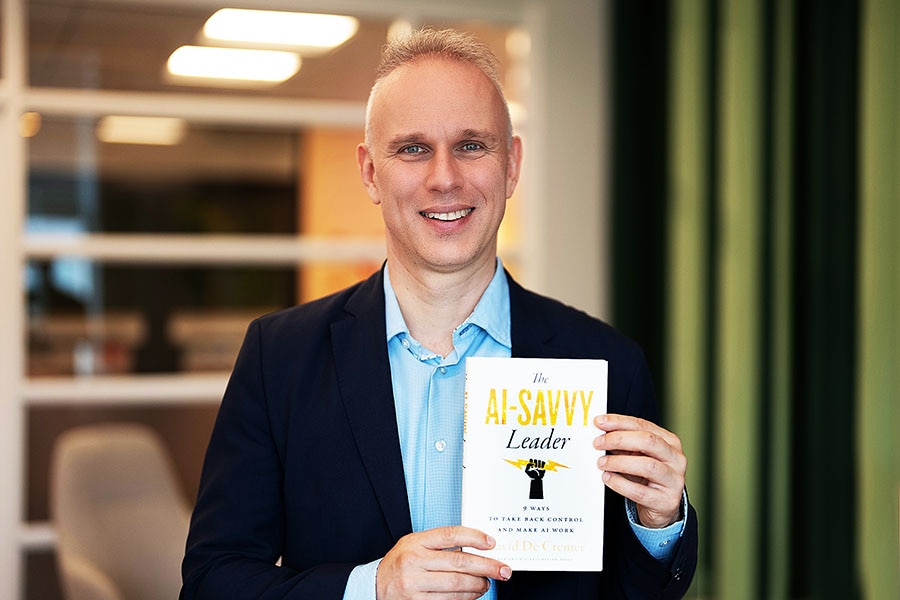Put humans first, AI second: David De Cremer
Business leaders need to create value by using AI in human-centered and responsible ways, says De Cremer, author and the Dunton Family Dean of the D'Amore-McKim School of Business and professor of management and technology at Northeastern University
 David De Cremer, Dunton Family Dean of the D'Amore-McKim School of Business and professor of management and technology at Northeastern University
David De Cremer, Dunton Family Dean of the D'Amore-McKim School of Business and professor of management and technology at Northeastern University
David De Cremer is the Dunton Family Dean of the D'Amore-McKim School of Business and professor of management and technology at Northeastern University. He is also the author of Leadership by Algorithm: Who leads and who follows in the AI era? and The AI Savvy Leader: 9 ways to take back control and make AI work. In an interview with Forbes India, he explains why leaders need to steer AI-driven transformation instead of delegating it to tech experts. Edited excerpts:
Q. What’s the leadership challenge with respect to AI adoption?
Organisations consider not using AI to be the biggest risk today, and this sense of urgency puts business leaders under enormous pressure. They must adjust to the use of this new technology but they do not understand it well enough. As a result, they delegate the management of the AI adoption process to the tech experts entirely. But, reality is that business leaders cannot delegate the responsibility of any AI adoption strategy. If they do, the wrong questions are likely to be asked as the business side of the tech is missing. We are already seeing the results: Many companies are sinking significant money into AI, but they are failing to extract value commensurate with the investment.
By prizing a technical mindset above all else for the rollout of AI adoption programmes, the transformation process is seen as only a technological endeavour. The human element is ignored and the organisational goals and purpose are not aligned with the deployment of AI. I wrote The AI-Savvy Leader to help reverse the trends I see in the companies I have worked with, the data I have reviewed, and the leaders I have spoken with. I want to bring leaders back into the AI conversation and to remind them that their leadership skills are essential if they want to turn AI into a true value-creator for their organisation.
Q. How would you define an AI-savvy leader?
An AI-savvy leader needs to have a foundational understanding of AI, which includes learning about AI at two levels. First, learn the basics of what AI is and what it is not. For example, AI does not understand the meaning and application of the concepts it learns, and it is not an active participant in society as humans are. On the other hand, AI works faster and more consistently in tasks where complete information is available and, with the new LLMs, can assist in generating content to achieve higher performance levels. Second, understanding what AI can do provides a foundation to enable you to next think about what AI means and looks like in your business context. Specifically, knowing the strengths and weaknesses of AI helps to drive your discussions with tech experts regarding the kind of AI to deploy and why. Being an AI-savvy leader thus goes beyond mere coding experience. Of course, you need to understand that AI relies on data and that most AI applications today in business are likely to be supervised (human supervision). Hence, a basic understanding of statistics is a must. Crucially, leaders need to understand why human intelligence is not the same as artificial intelligence. This will be that basic grounding to help you develop a narrative that clarifies the deployment of AI in light of the relevant business questions. By acquiring this narrative, they will also be more equipped to design and implement strategies to use it in augmenting and ethically correct ways.
Q. How can leaders turn AI into a value-creator?
Leaders need to understand the importance of data, statistics, and different types of AI combined with the insight that to mitigate risks, they need to keep humans in the loop when deploying this smart technology. Those who fear AI will not build a culture where there is room for experimentation and failure, and thus fail to nurture a mindset that also allows for any experimentation with this intelligent technology. As a result, companies do not learn about the potential AI can bring for them.
Also read: What Indian managers should know about Generative AI
Q. A human-centred approach to AI—how important is this?
One thing people often forget is that AI, even today at the height of large language model (LLM) applications, is still a tool. So, how will you as a business leader use that tool to create positive impact on your company and stakeholders? Two perspectives are dominant. The first sees AI as a primary means to enhance efficiency in everything they do. The problem, however, is that, in this perspective, work cultures emerge where humans feel pressured to align with how machines make decisions rather than the other way around. Employees in such AI-centred workforces will resist and withdraw participation.
The only way to create value on the long term is if humans and AI work together. For that, we need a behavioural, human-centred approach where AI is developed and employed in ways that align with how humans work, think, and decide. Business leaders, therefore, need to show that they see AI as a means and not an end.
Q. How can leaders drive human-AI collaboration in inclusive ways?
When leaders focus primarily on automation strategies (cost-effective strategies), they signal that AI is regarded by the organisation as more important than human capital, which makes employees nervous. Leaders need to empathise with this and develop a narrative that presents the use of AI as relevant to the organisational goals. By doing so, they convey the message that the organisation has the right intentions, while, at the same time, presenting AI as a tool that creates more flexible and supportive conditions for employees to grow in their jobs and perform better, which increases employees’ trust in the tech itself. So, leaders in the AI era need strong emotional intelligence in combination with the right change management skills where they include employees in the adoption process and promote their sense of control and feelings of autonomy.
Leaders or tech experts? Who should take the lead when it comes to data-driven decision-making?
Data can be used to help leaders make better decisions—but data are what they are: Data. Every organisation still needs to decide whether data are relevant and useful, and that requires a judgment call, which is a unique human ability. To decide when to stop looking at the data and apply it in decision-making requires the knowledge to align AI with business goals. This means that business leaders lead by asking the business questions that should be answered while tech experts put the right tech to work and make the right kind of data available.
Q. How relevant are soft skills in the AI journey?
Organisations thrive on soft skills because they increasingly rely on critical thinking, emotional judgement, and problem-solving skills to understand what precise value AI can bring to the organisation, how to apply it and put it to work so you can accommodate the needs of customers from different geographical and cultural backgrounds. In fact, we are moving towards a ‘feeling economy’, where soft skills will impact what individuals earn more than their hard skills. The issue is that if we put AI first and humans second, neuroscience predicts that we will pay less attention to soft skills, and ultimately get worse at them. We need to put them center-stage and keep training them.
Q. Can B-schools play a role in grooming leaders for an AI future?
Business schools have the pivotal task of educating our future leaders to be AI-savvy to create business value by using AI in human-centred and responsible ways. As a business school dean, I implemented the mission to educate socially responsible business leaders who can act, navigate, and create (as entrepreneurs and innovators) in a tech-driven environment. To achieve this mission, business schools must teach students a combination of AI literacy and human behaviour literacy. Future leaders need to be trained more than ever in being agile and adaptive, to ask the right kinds of questions, reflect and engage in critical thinking, and always have their thinking guided by a moral compass that puts any business decision in the right context. These skills will allow students to be ready to adjust to the new co-worker AI.

















